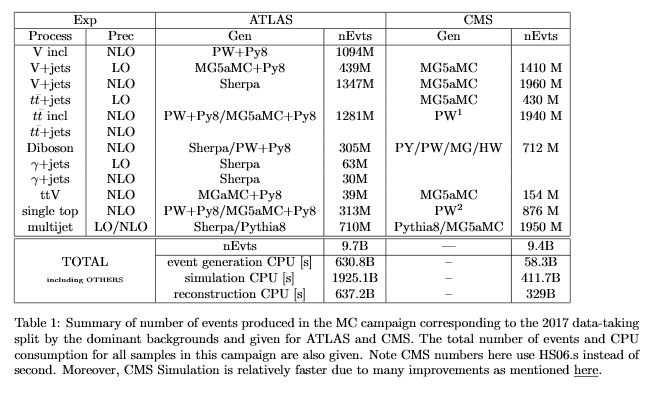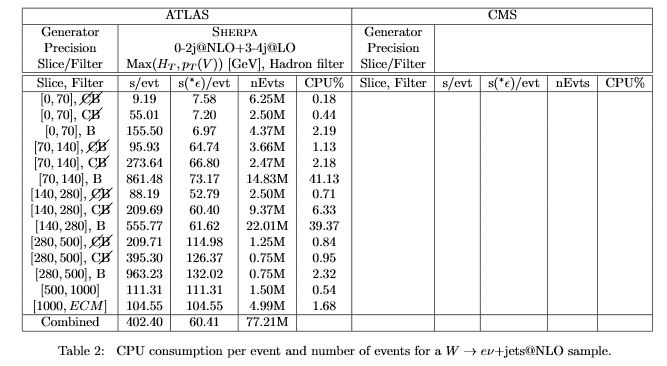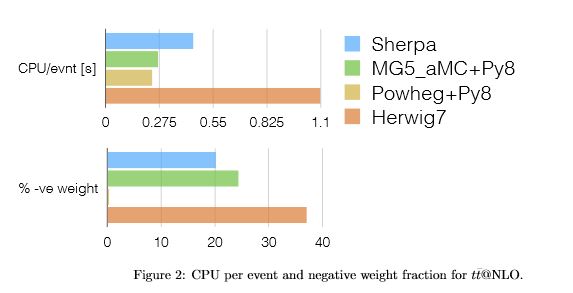HSF Generator Meeting #4, 28 March 2019
Agenda: https://indico.cern.ch/event/804266
Present/Contributors: Andrea Valassi, Josh McFayden, Servesh Muralidharan, Qiang Li, Frank Siegert, Graeme Stewart, Stephen Jiggins, Efe Yazgan
ATLAS and CMS event generator accounting update
- Latest numbers in https://www.overleaf.com/1326158343ftxgrxxcspxg

- Qiang: update on CMS accounting numbers (attached to the agenda):
- Official Numbers from CMS Computing:
- Gen+Sim = 50 sec/ev/core
- Digi: 10 sec/ev/ecore
- Reco: 25 sec/ev/core
- Assume 1 core = 10 HS06, note this introduces a 20% error at least.
- Table 1, CMS:
- Total Events: 1.41+1.96+0.43+1.94+0.712+0.154+0.876+1.95=9.4B
- GEN fraction ~7.3% (1.41*0.05 + 1.96*0.17 + 0.43*0.05 + 1.94*0.04 + 0.712*0.05 + 0.154*0.05 + 0.876*0.05 + 1.95*0.05)/9.4, where 0.05, 0.17 and 0.04 are from numbers achieved from local tests, presented in last meetings (DY LO MLM 5%, DY NLO 17%, TT powheg 4%, QCD 50to80 Pythia8 <1%)
- Thus GEN -> 85*7.3%=6.2 sec/ev/core (6.2*9.4B=58.3B)
- Official Numbers from CMS Computing:
- Qiang: this 7% is GEN as a fraction of MC production, but MC prod
is only ~50% of worldwide CMS computing, so this translates to
GEN being approximately 4%.
- Josh: note that 4% is still lower than the ATLAS number previously presented, but it is larger than the 1% previously presented by CMS at the CSRG. On the other hand, there are also some other small samples missing.
- Josh: will also change the ATLAS numbers to have a closer apples-to-apples comparison
- Josh on ATLAS numbers in the other tables.
- Andrea: would be nice now to concentrate on one biggest consumer, ie sherpa for ATLAS and MG for CMS in V+jets. Josh: this is exactly what I am trying to do in the next tables in the document. Table 2 is one V+jets (W→eν+jets@NLO).

- Josh: two columns for sec/evts, to take into account the generation time with and without filtering. Average 400 sec/event because many events are thrown away by filtering, while 60sec/event is intrinsic generator speed. Andrea: interesting, maybe CMS generation is faster also because of a different filtering.
- Josh: CPU% adds up to 100% for all rows. It is based on the first column, not the second.
- Would it be possible to get similar numbers as in Table 2 and 3 for CMS (from local tests?). Qiang: will try to get some numbers for the next meeting in two weeks.
- Josh on the next section on benchmarking (eg figure 2).
- Josh: we should think of a more meaningful way to present weight effect than just negative weight distribution. Andrea: could this be a multiplicative factor, “you have to generate and simulate 10 times as many events”? Frank: yes a multiplicative factor is probably what we need, but we need to convolute all sorts of effects, not just negative weights but also non-unity weights, so we definitely need to include weight distributions.

- Josh: in figure 4 the difference between blue and yellow is in the choice of the scale. Efe: please write down the scale choice, so we can try the same in CMS too. Frank: we should make sure that green MG and yellow sherpa are comparable.

AOB
- Josh to Andrea: any progress in investigating the use of some machines for benchmarking? Andrea: would help to get a five-line plan, do we need this one day per week, or one week every few months, is it bare metal, and so on.
- Graeme: there was a presentation by Junichi about Madgraph on GPUs. Should invite him along to one of these meetings. Graeme: will email him and cc the WG convenors.